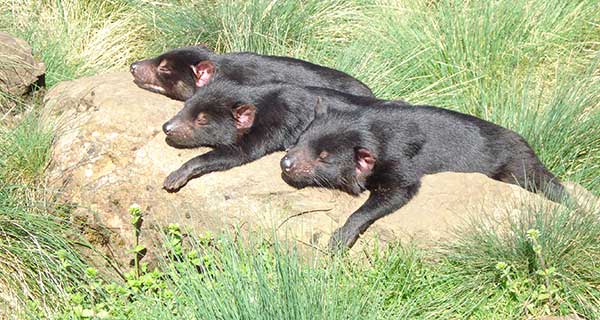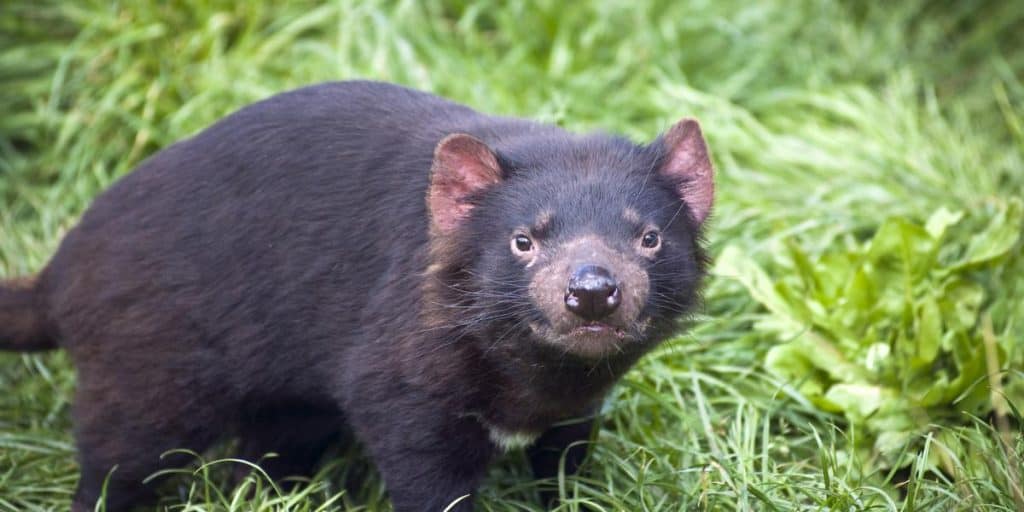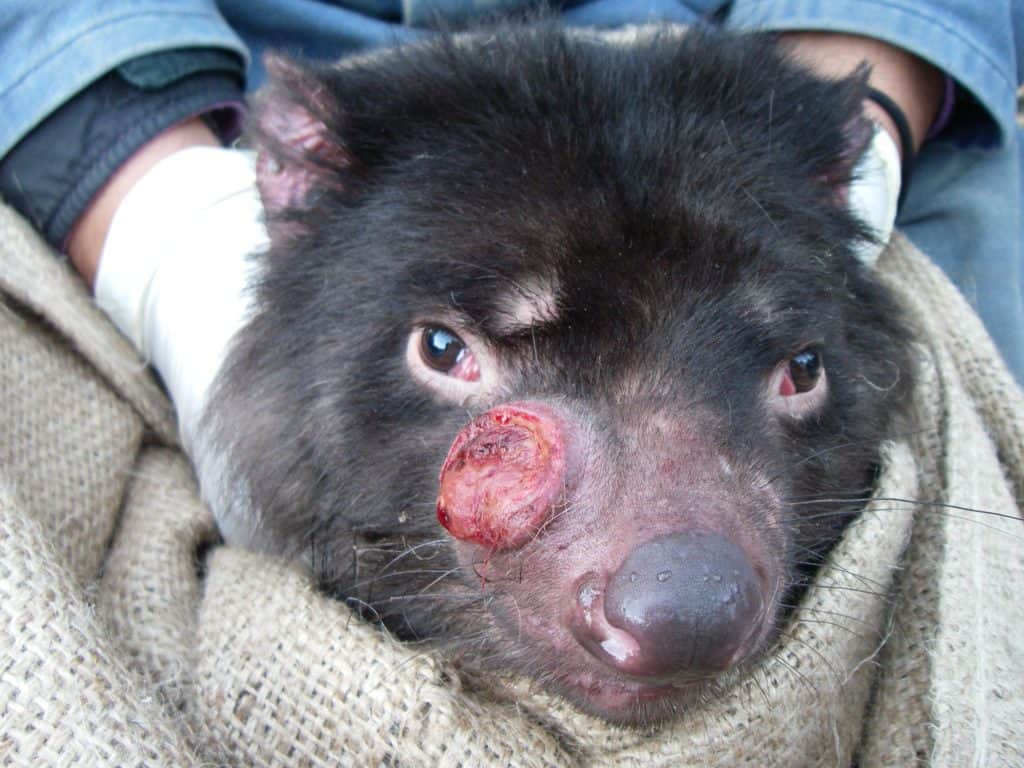

Here are 55 little known facts about the Tasmanian devil.
What is a Tasmanian Devil?
- Tasmanian devils are carnivorous marsupials, or mammals that have a pouch where they carry their young.
- Most marsupials are herbivorous, but not these deceptive creatures.
- The Tasmanian devil is scientifically named Sarcophilus harrisii, for their love for meat.
- It translated to “Harris’s Meat Lover”, after Pierre Boitard Harris, the scientist that discovered them in 1841.
They Have A Very Complicated Habitat History
- The habitat of the Tasmanian Devil is ever changing.
- Through the study of fossils, scientists believe that millions of years ago, before humans, ancient marsupials, a group that Tasmanian devils belong to, migrated from South America to Australia.
- It is believed that over time, they spread throughout Australia.
- Gradually, with the absence of dingoes (their primary predator) and the drastic climate change, they began to disappear from mainland Australia and migrated to the southern part of the country where they are known to be endemic today: Tasmania.
- In Tasmania, the Tasmanina devils were definitely thriving, and would actually start breaking into households and kill livestock, poultry animals, and pets, in addition to roadkills and hunting prey in the forest.
- In retaliation, humans started to hunt them to protect their livestock and for the little devils’ furs.

The Looney Toons Cartoons Grossly Misrepresented The Tasmanian Devils
- Are Tasmanian devils dangerous? You bet your penny they are.
- A real life Tasmanian devil is very different from the creature portrayed in the Looney Toons cartoons, Taz the devil.
- Taz neither looks like the Tasmanian devil nor, for the most part, acts like its real life counterpart.
- This is understandable since it’s a story for children and it would not have been right to scare them.
- A real life Tasmanian devil is loud, aggressive, and will bite your fingers off if you are not careful.
- It is the size of a small dog, has a squat and a thick build with a very large head.
- The tail is usually half as long as their whole body length.
- The two hind legs are somewhat short compared to the relatively thinner and shorter front legs (forelimbs).
- They may lack great speeds but they are good swimmers and climbers.
- Tasmanian devils are covered in black fur as opposed to the reddish brown one in the cartoon.
They Are Carnivorous Marsupials... And Are Now An Endangered Species
- Most marsupials like koalas and kangaroos are herbivorous, but among the carnivorous marsupials, the Tasmanian devil is the largest.
- A typical adult Tasmanian devil is as big as a small dog.
- On average, it is 600mm long and 8kg big.
- They eat too much and can eat various types of organisms, although they prefer carrion and road kill, fish, insects, reptiles, and amphibians.
- Apparently, the population of these animals is less than 20,000 as of late.

They May Be Responsible For The Extinction Of Their Closest, Much Larger Relative
- The Tasmanian devils once had a rival group of species called the Thylacines or more commonly referred to as the Tasmanian tigers or Tasmanian wolves, which are now extinct.
- The Tasmanian Tigers were much bigger rivals who also prey on Tasmanian Devils, but the devils had a trick up their furry paws.
- The devils protect and aggressively defend their own newborns from the tigers.
- The tigers that want to consume a devil must hunt and fight a fully grown one which is not an easy feat.
- Moreover, a young Tasmanian devil is way too small to be a satisfying meal, which increases their survival rate as the Tigers ignore them.
- Meanwhile, the Tasmanian tigers leave their newborns in nests which the Devils then seek out.
- The Devil preys on the offspring of the tiger in its absence and then eventually takes control of the tiger’s nest in order to protect its own females and children.
The Devil Screams; It’s Like Deafening Sirens
- Tasmanian Devils are called devils because of the sound they make at night.
- If you thought frogs and crickets make the loudest noise when you go camping in the woods, think again.
- Tasmanian devils are nocturnal animals.
- At night, during feeding time, inhabitants of Tasmania have often reported that the Tasmanian Devils tend to scream like someone is suffering from an excruciating death.
- The Tasmanian devils tend to cry and growl aggressively to ascertain dominance during feeding time as well.
The Jaw Of A Tasmanian Devil Could Crush Bones
- The jaws of a Tasmanian Devil carry enough brute force to crush bone.
- Their jaws can actually cut through the strongest of metals, so they could actually even break the cages of livestock and other animals.
- The Tasmanian devils use their incredibly strong and powerful jaws to consume game or roadkill without any leftovers.
- And since they also have a fast digestion, they can actually eat all day if they so wish.
They Have A Disturbing Feeding Habit
- Tasmanian Devils can feed on carrion, as well as sleep inside their bodies.
- They sleep inside rotten carcass, wake up, and continue feeding.
- The smell does not affect them.
- The Tasmanian devils are now considered to be endangered species and one of the primary causes is being hit by cars on the road, which only happens when they attempt to retrieve roadkill.
- Since their movements become very slow when carrying large objects, it becomes very easy to hit them especially since they are small and drivers may actually fail to notice them.
They Have A Violent Mating And Bizarre Birthing Process

- The male Tasmanian Devils take territoriality up a notch.
- They tend to kidnap their mate when they are fertile and aggressively guard them to prevent them from running off to another mate.
- After kidnapping their female counterpart, they begin the mating process which is usually very violent.
- Even more violent than that of praying mantises and bedbugs, which end up killing their partners.
- Apparently, both the male and the female tasmanian devils have a tendency to prove their worth; that one is tougher than the other, and it results in an aggressive mating process.
- The female Tasmanian devils have 4 nipples and they usually give birth to tens of offspring at once.
- 40 percent of their children die while in the pouch and this has also been a contributing factor in the endangered classification of the Tasmanian devils today.
They Carry A Pathogen Not Found In Any Other Animal Alive
- A major factor to their endangered nature is the pathogen, Dasyurotaenia robusta.
- It is a tapeworm that causes the Tasmanian devils to contract cancer, and has led to the death of 90% of the species for the past 23 years.

Tasmanian Devil cancer
Final Thoughts
After reading this, I’m sure there’s one less thing you don’t know about the Tasmanian devils. However, one must keep in mind that although they may be loud and aggressive animals, they are here on Earth for a reason as they also have their own share of contribution to the ecosystem, so let us also try to protect them so we can likewise prevent them from going extinct.
Was this page helpful?
Our commitment to delivering trustworthy and engaging content is at the heart of what we do. Each fact on our site is contributed by real users like you, bringing a wealth of diverse insights and information. To ensure the highest standards of accuracy and reliability, our dedicated editors meticulously review each submission. This process guarantees that the facts we share are not only fascinating but also credible. Trust in our commitment to quality and authenticity as you explore and learn with us.

